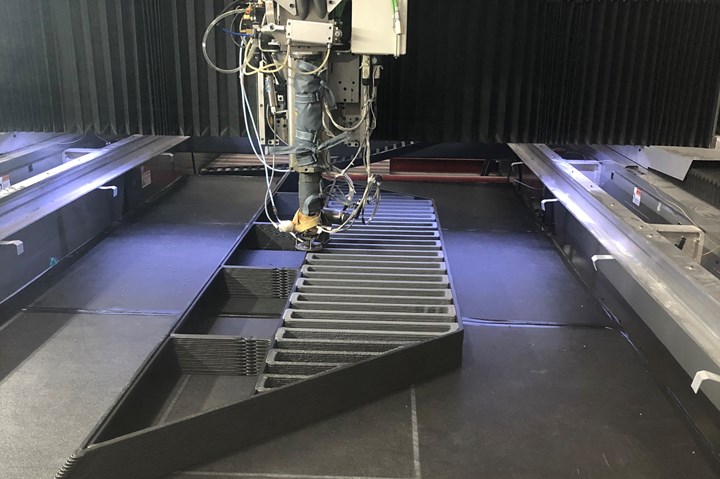
Cincinnati Inc. BAAM system printing with recycled materials. Photo Credit: Cincinnati Inc.
Cincinnati Inc. (CI, Harrison, Ohio, U.S.), manufacturer of the Big Area Additive Manufacturing (BAAM) machine, the world’s first large-format additive manufacturing system, has been used to demonstrate that recycled materials can be used for 3D printing by producing one of the largest monolithic multi-material objects to date. The demonstration successfully proved that large-scale, multi-material printing can be done effectively and economically with recycled composite materials.
The large-format, multi-material print was achieved by making modifications to the BAAM, including a new extruder design that accommodates a dual-feed system. “The objective of this particular study was to demonstrate printing of a multi-material composites tool including transitions, exceeding 10 feet in length, containing recycled material and printed without manual intervention,” says Alex Riestenberg, CI’s additive manufacturing product manager. The part selected for the demonstration was a single facet of a precast concrete tool used in the production of commercial window panels for a high-rise development in New York City. The mold weighed approximately 400 pounds, with a length of 10 feet, 10 inches. Print time was approximately seven hours.
The two materials used in the build were a blend that contained 100% recycled carbon fiber/ABS and virgin carbon fiber/ABS and ABS syntactic foam. The enabling technology, developed with Oak Ridge National Laboratory (ORNL, Oak Ridge, Tenn., U.S.), was a large dual-material thermoplastic extrusion system that allows the user to print with multiple materials in a single build using one extruder.
“The source of material fed into the extruder is switched on the fly at specific times during a print by sliding two material ports back and forth over the infeed to the extruder,” says Riestenberg. “The system also includes a material blender outside the frame of the machine that can blend specific amounts of different materials and fillers on the fly for specific custom material grades.”
Related Content
-
The lessons behind OceanGate
Carbon fiber composites faced much criticism in the wake of the OceanGate submersible accident. CW’s publisher Jeff Sloan explains that it’s not that simple.
-
Cryo-compressed hydrogen, the best solution for storage and refueling stations?
Cryomotive’s CRYOGAS solution claims the highest storage density, lowest refueling cost and widest operating range without H2 losses while using one-fifth the carbon fiber required in compressed gas tanks.
-
Natural fiber composites: Growing to fit sustainability needs
Led by global and industry-wide sustainability goals, commercial interest in flax and hemp fiber-reinforced composites grows into higher-performance, higher-volume applications.













